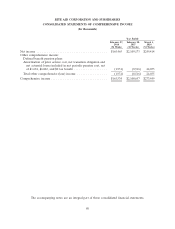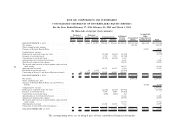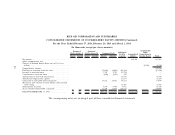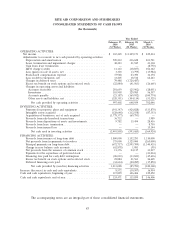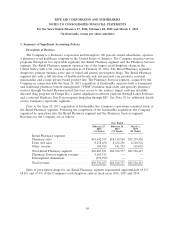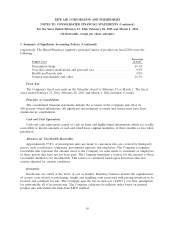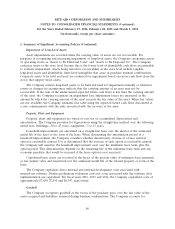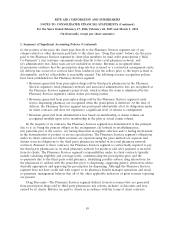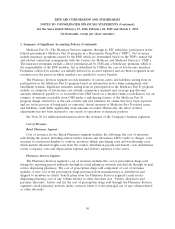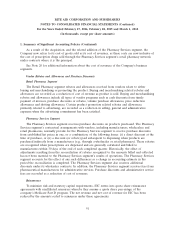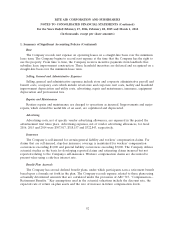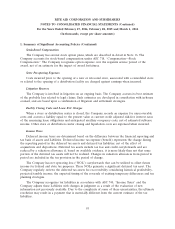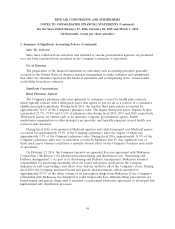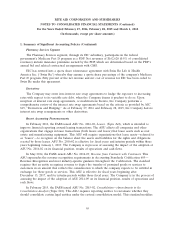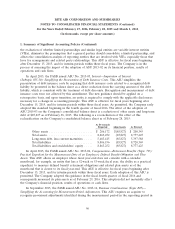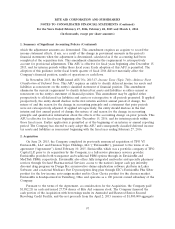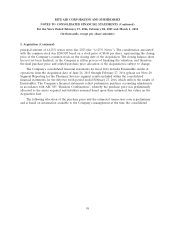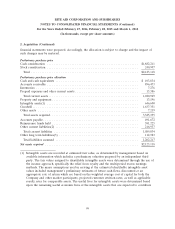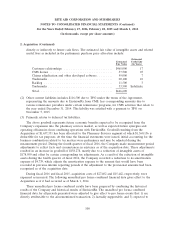Rite Aid 2016 Annual Report Download - page 90
Download and view the complete annual report
Please find page 90 of the 2016 Rite Aid annual report below. You can navigate through the pages in the report by either clicking on the pages listed below, or by using the keyword search tool below to find specific information within the annual report.RITE AID CORPORATION AND SUBSIDIARIES
NOTES TO CONSOLIDATED FINANCIAL STATEMENTS (Continued)
For the Years Ended February 27, 2016, February 28, 2015 and March 1, 2014
(In thousands, except per share amounts)
1. Summary of Significant Accounting Policies (Continued)
Medicare Part D—The Pharmacy Services segment, through its EIC subsidiary, participates in the
federal government’s Medicare Part D program as a Prescription Drug Plan (‘‘PDP’’). Net revenues
include insurance premiums earned by the PDP, which are determined based on the PDP’s annual bid
and related contractual arrangements with the Centers for Medicare and Medicaid Services (‘‘CMS’’).
The insurance premiums include a direct premium paid by CMS and a beneficiary premium, which is
the responsibility of the PDP member, but is subsidized by CMS in the case of low-income members.
Premiums collected in advance are initially deferred in accrued expenses and are then recognized in net
revenues over the period in which members are entitled to receive benefits.
The Pharmacy Services segment records estimates of various assets and liabilities arising from its
participation in the Medicare Part D program based on information in its claims management and
enrollment systems. Significant estimates arising from its participation in the Medicare Part D program
include: (i) estimates of low-income cost subsidy, reinsurance amounts and coverage gap discount
amounts ultimately payable to or receivable from CMS based on a detailed claims reconciliation, (ii) an
estimate of amounts receivable from CMS under a risk-sharing feature of the Medicare Part D
program design, referred to as the risk corridor and (iii) estimates for claims that have been reported
and are in the process of being paid or contested. Actual amounts of Medicare Part D-related assets
and liabilities could differ significantly from amounts recorded. Historically, the effect of these
adjustments has not been material to our results of operations or financial position.
See Note 20 for additional information about the revenues of the Company’s business segments.
Cost of Revenues
Retail Pharmacy Segment
Cost of revenues for the Retail Pharmacy segment includes the following: the cost of inventory
sold during the period, including related vendor rebates and allowances, LIFO credit or charges, costs
incurred to return merchandise to vendors, inventory shrink, purchasing costs and warehousing costs,
which include inbound freight costs from the vendor, distribution payroll and benefit costs, distribution
center occupancy costs and depreciation expense and delivery expenses to the stores.
Pharmacy Services Segment
The Pharmacy Services segment’s cost of revenues includes the cost of prescription drugs sold
during the reporting period indirectly through its retail pharmacy network and directly through its mail
service dispensing pharmacy. The cost of prescription drugs sold component of cost of revenues
includes: (i) the cost of the prescription drugs purchased from manufacturers or distributors and
shipped to members in clients’ benefit plans from the Pharmacy Services segment’s mail service
dispensing pharmacy, net of any volume-related or other discounts (see ‘‘Vendor allowances and
purchase discounts’’ below) and (ii) the cost of prescription drugs sold through the Pharmacy Services
segment’s retail pharmacy network under contracts where it is the principal, net of any volume-related
or other discounts.
90


